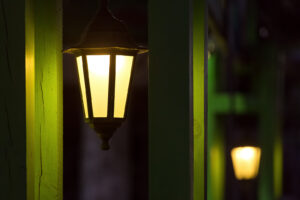Blog
- Home
- Resources
- Bright Ideas Blog
- A Lighting Specialist’s Responsibility with Dark-Sky Outdoor Lighting
A Lighting Specialist’s Responsibility with Dark-Sky Outdoor Lighting

What is Dark-Sky Lighting?
In a growing number of communities across the country, dark-sky ordinances are being mandated in order to control light pollution. These ordinances require property owners to outfit their buildings with dark-sky lighting fixtures, such as shields. LEDs and reflectors, as well as specific bulb types and cut-off angles. These fixtures direct light downwards towards the ground instead of out to the sides or upwards into the sky. Poorly positioned outdoor lights can cause light trespass, which sends light sideways from the bulb and illuminates other structures, or skyglow, which causes it to bounce upwards.
Why is Dark-Sky Lighting Necessary?
According to the International Dark-Sky Association, 80% of the world’s population lives under skyglow. Overpowering light pollution disrupts natural day-night patterns and is causing a shift in the balance of Earth’s environment. The IDA asserts that light pollution can be linked to disruption of the ecosystem and wildlife, increased energy consumption, and harmful effects on human health. Additionally, 30% of vertebrates and 60% of invertebrates are nocturnal, meaning their health and ability to function depends on darkness. Light pollution poses a threat to their biologically evolved patterns and could be hazardous to their ultimate survival.
Lighting specialists, manufacturers and distributors have a responsibility to offer lighting fixtures that allow commercial property owners to reduce light waste. At the same time, exterior lighting is a critical part of maintaining a safe environment. Guests, staff, tenants, and other visitors must be able to see clearly throughout an entire property. Otherwise, there is a risk of accidents, injury, or even crime. Lighting specialists are therefore tasked with ensuring people are safe in commercial spaces by providing adequate, quality illumination that directs light downward. An experienced professional knows that selecting dark sky lighting is critical for improving visibility and maintaining compliance with dark sky ordinances and will be able to help any commercial property owner select the right products.
How Can Lighting Professionals Positively Impact the Dark Sky Movement?
The people who create, distribute, select and install outdoor commercial lighting must adapt to the growing demand for dark-sky compliant lighting in order to help reduce light pollution. They must strike a balance between the needs for human safety and well-being with the needs to the environment and ecosystem at large. In the words of IDA executive director Ruskin Hartley, “We were never about turning the lights off; we were always about promoting the responsible use of light.” Given that, in order for this movement to have impact, dark-sky lights must be widely available. Lighting professionals are responsible for working as a unit to provide their customers with appropriate outdoor lighting.
Lighting manufacturers must continue to create products that are dark-sky compliant. These products will have the IDA’s Fixture Seal of Approval, meaning they minimize glare and reduce light trespass and skyglow. Examples include:
- Warm correlated color temperature (CCT) lamps
- Motion sensors
- Dimmer technology
- Timers
- Task lighting
- Downlights
Lighting distributers are responsible for partnering with these manufacturers in order to make these products available to the public. IDA-approved lighting products can then be chosen and installed by lighting specialists in commercial properties across the U.S. Manufacturers, distributors, and specialists are tasked with helping commercial property owners use light more efficiently and with lower levels of waste and greenhouse gas emissions.
What to Look for in Commercial Outdoor Lighting
An estimated $3 billion per year in energy costs is lost due to poor lighting. 35% of light is wasted via unshielded and/or improperly aimed outdoor lighting. For commercial property owners, it is best to partner with a lighting specialist who can guide you through the process of choosing and installing IDA-compliant lighting. Overall, however, there are a few major factors to consider. The Illuminating Engineering Society of North America recommends compliance with the following Five Principles for Responsible Outdoor Lighting:
- Installation when and were there is a clear purpose
- Downward targeting of light beams
- Brightness levels not exceeding necessity
- Use of motion detectors, timers, and similar technology
- Use of warmer-color lights
- Limitation of light with shorter wavelengths (blue-violet)
Think about the amount of foot or car traffic various parts of your property see on a day-to-day basis. If they do not need to be lit 24/7, using motion sensors and other similar features can drastically reduce light waste. With LED and decreasing the wattage on exterior bulbs can help create a balance in brightness that allows for better clarity. Walkway and driveway lighting should direct light down towards the ground, as should all other exterior lighting. Shielded fixtures can produce the same illumination levels as unshielded fixtures can at a lower cost and with less energy waste. Overall, lighting placed throughout a property’s exterior should have purpose. Lighting that does not serve a clear, useful purpose is creating light pollution and energy waste, not to mention costing property owners a fortune. This is where it’s important to work with someone who knows lighting. A specialist can help you determine which areas require lighting and which don’t, proper illumination levels and CCT, and which fixture has the optimal beam direction and spread.
The Future of Dark Skies
Research suggests that the number of artificially lit areas worldwide increases 2.2% annually worldwide. Making dark-sky lighting more available and accessible is the best way lighting professionals can help mitigate this growing problem. In doing so, the lighting industry can contribute to environments with improved nighttime visibility, increased night sky access, and reduced consequences for humans, wildlife, and Earth’s ecosystem. Installing quality outdoor lighting can reduce energy use by 60-70%. Over time, this can add up to a significant amount of energy and cost savings for any organization. Additionally, as more commercial buildings are outfitted with dark-sky lighting, light pollution will begin to decrease, along with the energy waste and other hazardous effects associated with it. In the words of author Robert Alan Silverstein, “We can create a more sustainable, cleaner and safer word by making wiser energy choices.”
Contact Us
If you are interested in upgrading to dark-sky lighting or discussing IDA compliance, contact Bay Lighting today. We work with commercial properties across Maryland, Washington, D.C., and Virginia in order to provide a wide range of responsible outdoor lighting solutions. Call 301-858-9494 today.




